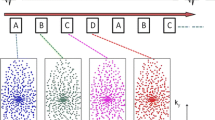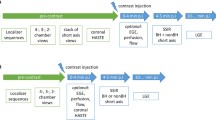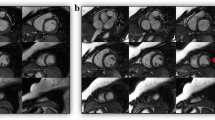Abstract
Objectives
Interest in cardiovascular magnetic resonance (CMR) at 7 T is motivated by the expected increase in spatial and temporal resolution, but the method is technically challenging. We examined the feasibility of cardiac chamber quantification at 7 T.
Methods
A stack of short axes covering the left ventricle was obtained in nine healthy male volunteers. At 1.5 T, steady-state free precession (SSFP) and fast gradient echo (FGRE) cine imaging with 7 mm slice thickness (STH) were used. At 7 T, FGRE with 7 mm and 4 mm STH were applied. End-diastolic volume, end-systolic volume, ejection fraction and mass were calculated.
Results
All 7 T examinations provided excellent blood/myocardium contrast for all slice directions. No significant difference was found regarding ejection fraction and cardiac volumes between SSFP at 1.5 T and FGRE at 7 T, while volumes obtained from FGRE at 1.5 T were underestimated. Cardiac mass derived from FGRE at 1.5 and 7 T was larger than obtained from SSFP at 1.5 T. Agreement of volumes and mass between SSFP at 1.5 T and FGRE improved for FGRE at 7 T when combined with an STH reduction to 4 mm.
Conclusions
This pilot study demonstrates that cardiac chamber quantification at 7 T using FGRE is feasible and agrees closely with SSFP at 1.5 T.







Similar content being viewed by others
References
Pettigrew RI (1989) Dynamic cardiac MR imaging techniques and applications. Radiol Clin North Am 27:1183–1203
Hinton DP, Wald LL, Pitts J, Schmitt F (2003) Comparison of cardiac MRI on 1.5 and 3.0 Tesla clinical whole body systems. Invest Radiol 38:436–442
Gutberlet M, Noeske R, Schwinge K, Freyhardt P, Felix R, Niendorf T (2006) Comprehensive cardiac magnetic resonance imaging at 3.0 Tesla: feasibility and implications for clinical applications. Invest Radiol 41:154–167
Ocali O, Atalar E (1998) Ultimate intrinsic signal-to-noise ratio in MRI. Magn Reson Med 39:462–473
Hecht EM, Lee RF, Taouli B, Sodickson DK (2007) Perspectives on body MR imaging at ultrahigh field. Magn Reson Imaging Clin N Am 15:449–465
Mainero C, Benner T, Radding A, van der Kouwe A, Jensen R, Rosen BR, Kinkel RP (2009) In vivo imaging of cortical pathology in multiple sclerosis using ultra-high field MRI. Neurology 73:941–948
Vaughan JT, Snyder CJ, DelaBarre LJ, Bolan PJ, Tian J, Bolinger L, Adriany G, Andersen P, Strupp J, Ugurbil K (2009) Whole-body imaging at 7 T: preliminary results. Magn Reson Med 61:244–248
Snyder CJ, DelaBarre L, Metzger GJ, van de Moortele PF, Akgun C, Ugurbil K, Vaughan JT (2009) Initial results of cardiac imaging at 7 Tesla. Magn Reson Med 61:517–524
Frauenrath T, Hezel F, Heinrichs U, Kozerke S, Utting JF, Kob M, Butenweg C, Boesiger P, Niendorf T (2009) Feasibility of cardiac gating free of interference with electro-magnetic fields at 1.5 Tesla, 3.0 Tesla and 7.0 Tesla using an MR-stethoscope. Invest Radiol 44:539–547
Thiele H, Nagel E, Paetsch I, Schnackenburg B, Bornstedt A, Kouwenhoven M, Wahl A, Schuler G, Fleck E (2001) Functional cardiac MR imaging with steady-state free precession (SSFP) significantly improves endocardial border delineation without contrast agents. J Magn Reson Imaging 14:362–367
Schar M, Kozerke S, Fischer SE, Boesiger P (2004) Cardiac SSFP imaging at 3 Tesla. Magn Reson Med 51:799–806
Fuchs F, Laub G, Othomo K (2003) TrueFISP–technical considerations and cardiovascular applications. Eur J Radiol 46:28–32
Keenan NG, Pennell DJ (2007) CMR of ventricular function. Echocardiography 24:185–193
Hendel RC, Patel MR, Kramer CM, Poon M, Hendel RC, Carr JC, Gerstad NA, Gillam LD, Hodgson JM, Kim RJ, Kramer CM, Lesser JR, Martin ET, Messer JV, Redberg RF, Rubin GD, Rumsfeld JS, Taylor AJ, Weigold WG, Woodard PK, Brindis RG, Hendel RC, Douglas PS, Peterson ED, Wolk MJ, Allen JM, Patel MR (2006) ACCF/ACR/SCCT/SCMR/ASNC/NASCI/SCAI/SIR 2006 appropriateness criteria for cardiac computed tomography and cardiac magnetic resonance imaging: a report of the American College of Cardiology Foundation Quality Strategic Directions Committee Appropriateness Criteria Working Group, American College of Radiology, Society of Cardiovascular Computed Tomography, Society for Cardiovascular Magnetic Resonance, American Society of Nuclear Cardiology, North American Society for Cardiac Imaging, Society for Cardiovascular Angiography and Interventions, and Society of Interventional Radiology. J Am Coll Cardiol 48:1475–1497
Becker M, Frauenrath T, Hezel F, Krombach GA, Kremer U, Koppers B, Butenweg C, Goemmel A, Utting JF, Schulz-Menger J, Niendorf T (2009) Comparison of left ventricular function assessment using phonocardiogram- and electrocardiogram-triggered 2D SSFP CINE MR imaging at 1.5 T and 3.0 T. Eur Radiol 20:1344–1355
Frauenrath T, Niendorf T, Kob M (2008) Acoustic method for synchronization of magnetic resonance imaging (MRI). Acta Acust 94:148–155
Moon JC, Lorenz CH, Francis JM, Smith GC, Pennell DJ (2002) Breath-hold FLASH and FISP cardiovascular MR imaging: left ventricular volume differences and reproducibility. Radiology 223:789–797
Maceira AM, Prasad SK, Khan M, Pennell DJ (2006) Normalized left ventricular systolic and diastolic function by steady state free precession cardiovascular magnetic resonance. J Cardiovasc Magn Reson 8:417–426
Grothues F, Boenigk H, Graessner J, Kanowski M, Klein HU (2007) Balanced steady-state free precession vs. segmented fast low-angle shot for the evaluation of ventricular volumes, mass, and function at 3 Tesla. J Magn Reson Imaging 26:392–400
Niendorf T, Sodickson DK (2008) Highly accelerated cardiovascular MR imaging using many channel technology: concepts and clinical applications. Eur Radiol 18:87–102
Versluis MJ, Tsekos N, Smith NB, Webb AG (2009) Simple RF design for human functional and morphological cardiac imaging at 7tesla. J Magn Reson 200:161–166
Plein S, Bloomer TN, Ridgway JP, Jones TR, Bainbridge GJ, Sivananthan MU (2001) Steady-state free precession magnetic resonance imaging of the heart: comparison with segmented k-space gradient-echo imaging. J Magn Reson Imaging 14:230–236
Barkhausen J, Ruehm SG, Goyen M, Buck T, Laub G, Debatin JF (2001) MR evaluation of ventricular function: true fast imaging with steady-state precession versus fast low-angle shot cine MR imaging: feasibility study. Radiology 219:264–269
Alfakih K, Plein S, Thiele H, Jones T, Ridgway JP, Sivananthan MU (2003) Normal human left and right ventricular dimensions for MRI as assessed by turbo gradient echo and steady-state free precession imaging sequences. J Magn Reson Imaging 17:323–329
Li W, Stern JS, Mai VM, Pierchala LN, Edelman RR, Prasad PV (2002) MR assessment of left ventricular function: quantitative comparison of fast imaging employing steady-state acquisition (FIESTA) with fast gradient echo cine technique. J Magn Reson Imaging 16:559–564
Hudsmith LE, Petersen SE, Tyler DJ, Francis JM, Cheng AS, Clarke K, Selvanayagam JB, Robson MD, Neubauer S (2006) Determination of cardiac volumes and mass with FLASH and SSFP cine sequences at 1.5 vs. 3 Tesla: a validation study. J Magn Reson Imaging 24:312–318
Malayeri AA, Johnson WC, Macedo R, Bathon J, Lima JA, Bluemke DA (2008) Cardiac cine MRI: quantification of the relationship between fast gradient echo and steady-state free precession for determination of myocardial mass and volumes. J Magn Reson Imaging 28:60–66
von Knobelsdorff-Brenkenhoff F, Rudolph A, Wassmuth R, Bohl S, Buschmann EE, Abdel-Aty H, Dietz R, Schulz-Menger J (2009) Feasibility of cardiovascular magnetic resonance to assess the orifice area of aortic bioprostheses. Circ Cardiovasc Imaging 2:397–404
Author information
Authors and Affiliations
Corresponding author
Electronic supplemental material
Below is the link to the electronic supplementary material.
Video file 1
Two-chamber view obtained by FGRE cine imaging at 7 T with 4-mm slice thickness underlining the excellent blood/myocardium contrast even in the left ventricular apex (AVI 5764 kb)
Video file 2
Short-axis view obtained by FGRE cine imaging at 7 T with 4-mm slice thickness underlining the excellent blood/myocardium contrast and delineation of the left ventricular papillary muscle apparatus and the right ventricular trabeculae (AVI 5764 kb)
Video file 3
Four-chamber view by FGRE cine imaging at 7 T with 4-mm slice thickness emphasising the detailed visualisation of right ventricular trabeculae (AVI 5764 kb)
Video file 4
Cross-sectional view of the aortic valve including views of the pulmonary and tricuspid valves by FGRE cine imaging at 7 T with 4-mm slice thickness (AVI 5764 kb)
Rights and permissions
About this article
Cite this article
von Knobelsdorff-Brenkenhoff, F., Frauenrath, T., Prothmann, M. et al. Cardiac chamber quantification using magnetic resonance imaging at 7 Tesla—a pilot study. Eur Radiol 20, 2844–2852 (2010). https://doi.org/10.1007/s00330-010-1888-2
Received:
Accepted:
Published:
Issue Date:
DOI: https://doi.org/10.1007/s00330-010-1888-2




